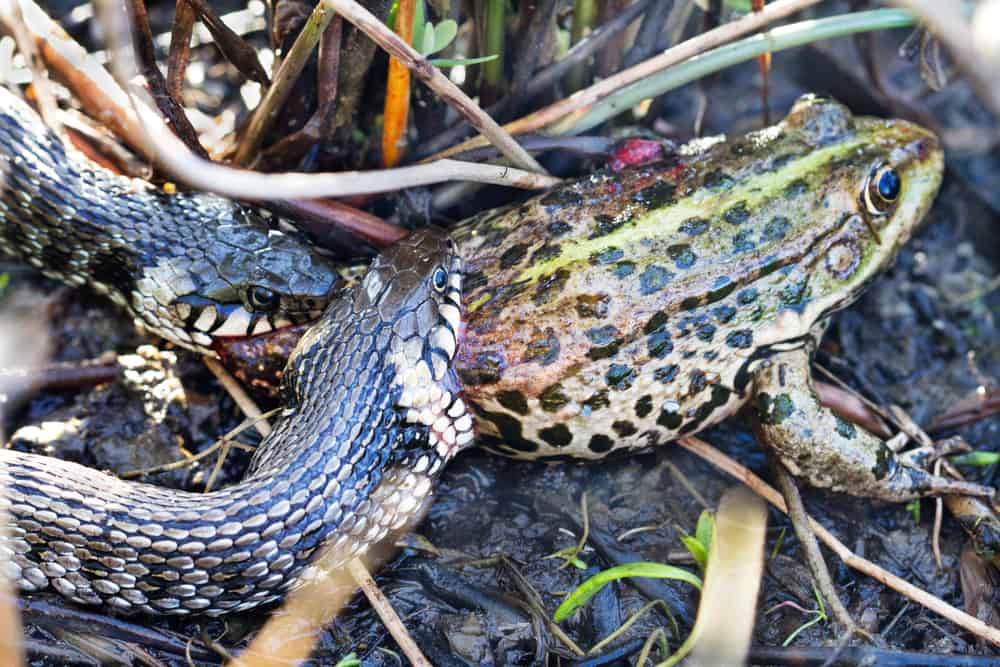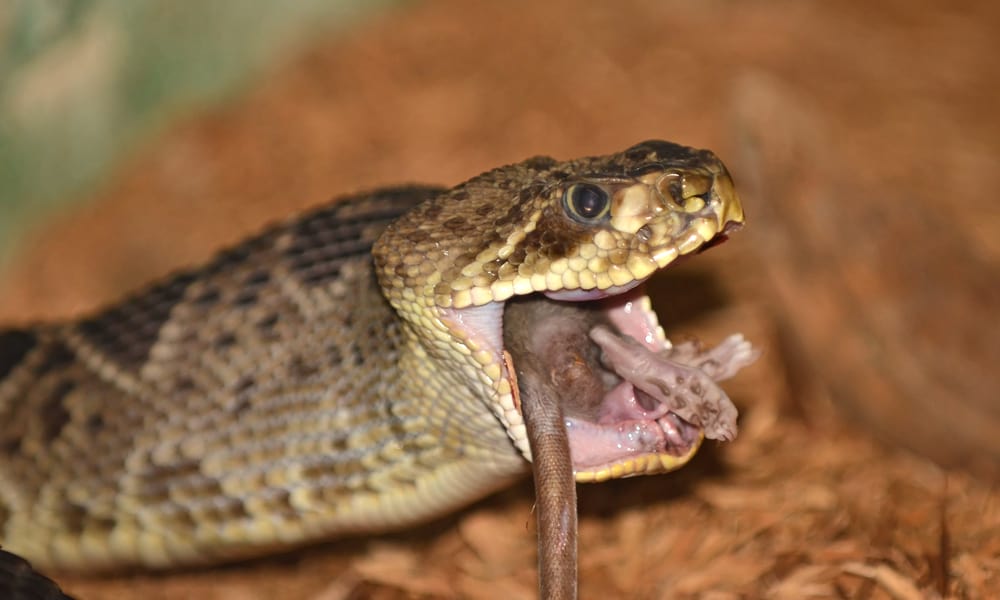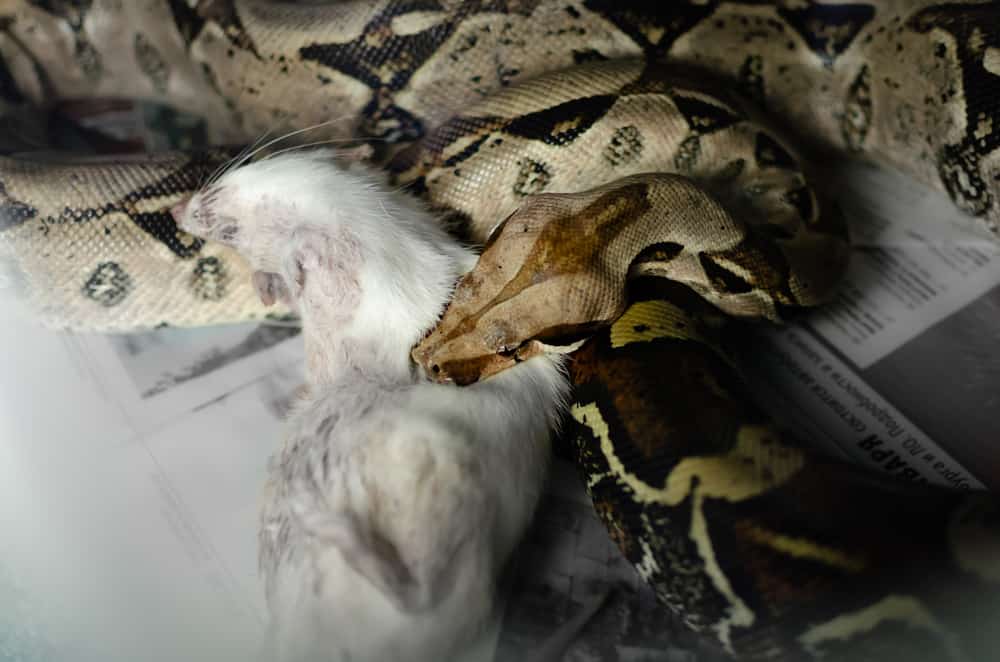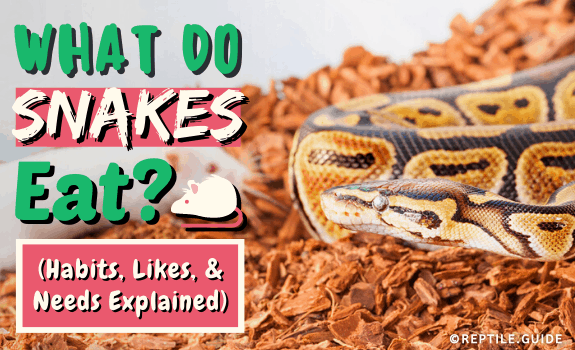All snakes are carnivores, meaning they (must) eat meat in order to survive.
Each of the 3000 different global snake species specializes in different types of prey. This includes various sizes of mammals, amphibians, fish, eggs, and other reptiles.
Snakes exist across a WIDE range of habitats – from arid deserts to the open ocean and even the artic circle.
Still: vegetarian snakes are not a thing.
At most, snakes will occasionally consume plant matter by accident while feeding.
Below you’ll learn which US-native snakes you’ll want to keep around for pest control and what to actually feed your pet snakes.
In This Article
What Do Snakes Eat?
Snakes can eat a wide range of prey items.
The largest snakes feed mostly on medium-sized mammalian prey like antelope and capybara.
Some large snakes – like this Burmese python – have even been known to take down alligators and caiman!
Snakes generally do not feed on humans, but some of the largest species have reportedly eaten humans.
The smallest snakes in the world -the blind snakes – feed on earthworms.
The African egg eating snake is known for its appetite for eggs, which can be many times larger than the snake’s own head!
Slug eating snakes can even suck a snail right out of its shell!

Common U.S. Snakes and Their Diets
In this section, we’ll outline the dietary preferences of most common garden snakes found in the U.S.
Garter snakes eat a range of small prey, including rodents, amphibians, and other reptiles.
Corn snakes and other rat snakes feed (unsurprisingly) on rats and other rodents.
These species are also prone to raiding chicken coops and feeding on eggs!
Kingsnakes are known to feed on other snakes, even venomous species!
Being a harmless species themselves, having kingsnakes around (by providing suitable habitat) is a great way to keep venomous species away.
Ringneck snakes feed mostly on amphibians (like small newts and salamanders) as well as earthworms.
Their small size prevents them from eating rodents.
Grass snakes – a common name often used to refer to rough and smooth green snakes – feed mostly on insects.
As with ringneck snakes, their small size prevents them from taking on larger prey.
Expert Tip: European grass snakes (Genus: Natrix) are much larger than American grass snakes (Genus: Opheodrys).
They feed mostly on amphibians such as newts, frogs, and toads.
Black snakes – and other racers – mostly eat mice, lizards, and frogs.
Milk snakes are fairly generalist predators and will eat most prey small enough to fit in their mouths.
Water snakes are known for stealing fish from anglers. They also eat lots of amphibians such as salamanders and frogs.
Hognose snakes feed mostly on frogs and small mammals.
Rattlesnakes are specifically adapted to feed on mammals.
These highly venomous snakes have heat-sensing pits to help them to locate warm-blooded prey and rarely eat other animals.

What Do Baby Snakes Eat?
As we mentioned before, all snakes are carnivores. Baby snakes, like their parents, have to consume animal protein.
This means that they have to hunt anything that will fit in their mouths – frogs, insects, mice, and any other animals that are small enough.
Baby snakes usually follow a similar diet to their parents.
If the adults only eat warm-blooded prey, then juveniles will possess the same instinctive preferences.
The only real difference between the diet of the fully-grown snake and its baby is the size of the meal.
In the wild, the juvenile’s diet will also depend on their habitat and what is available to them.
Though the snake’s prey is much smaller during their early years, a baby snake can still consume prey significantly larger than its head.
It’s also important to know that juvenile venomous snakes have their venom from birth in order to allow them to hunt effectively.
If you see a baby snake in the wild make sure to give it plenty of space, no matter how cute it may look!
In the next section, you’ll learn what to feed a pet snake (though it varies from species to species).
What Do Pet Snakes Eat?
A pet snake’s diet is usually more standardized than those of its wild counterparts.
In the wild, many snakes will consume anything that fits in their mouths.
Snakes in captivity tend to be fed those species which are widely available commercially.
It’s still important to feed your animal food that is appropriate for its species.
Snakes that would normally hunt a number of small mammals in the wild, usually eat pre-killed food in captivity.
Frozen rodents (like pinkies, fuzzies, mice, and rats) are the best choice for most snakes depending on their size.

It may seem that feeding a pet snake live prey would imitate its natural environment and provide it with enrichment.
However, captive snakes should never be fed live mice (or any other rodent) as this can lead to serious injury to the reptile.
If your snake is unwilling to feed on pre-killed prey, check with your local exotic vet to see if there is any underlying problem affecting its appetite.
Because snakes swallow their prey whole, mice can be a nutritionally – complete diet for them.
You don’t need to add supplements to keep these carnivorous reptiles healthy and happy.
Some larger pet snakes (like Burmese pythons) may need to be fed whole rabbits in order to meet their caloric needs.
Other snakes, like the rough green snake, are too small to feed on rodents and instead thrive on a diet of insects.
Crickets, grasshoppers, moths, and earthworms all make good meals for insectivorous snakes.
Some snakes (like the kingsnakes and king cobra) are adapted to eat other snakes in the wild.
Luckily, snake-eating species will often take rodents in captivity (and do just fine).
You should always research a species and its dietary needs BEFORE bringing one home.
What do you feed your snakes? Let us know in the comment section below.
Did you know that some snakes have lower jaws that can dislocate to help the snake swallow large prey items?
Find out more about their fascinating skeletal systems.
